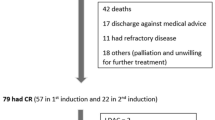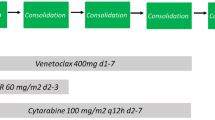Abstract
In this study, we compared the efficacy of mitoxantrone in combination with intermediate-dose cytarabine (HAM) with that of high-dose cytarabine alone (HiDAC) as consolidation regimens in non-acute promyelocytic leukemia (APL) acute myeloid leukemia patients with favorable and intermediate cytogenetics. A total of 62 patients from Shenzhen People's Hospital were enrolled in this study. All patients enrolled received standard induction chemotherapy and achieved the first complete remission (CR1). In these patients, 24 received HiDAC and 38 received HAM as consolidation. The median relapse free survival (RFS) and overall survival (OS) were similar between these two consolidation regimens. Even in subgroup analysis according to risk stratification, the combination regimen conferred no benefit in longterm outcome in patients with favorable or intermediate cytogenetics. However, in patients receiving HAM regimen, the lowest neutrophil count was lower, neutropenic period longer, neutropenic fever rate higher, and more platelet transfusion support was required. HAM group also tended to have higher rate of sepsis than HiDAC group. According to our results, we suggest that combination treatment with mitoxantrone and intermediate-dose cytarabine has limited value as compared to HiDAC, even in young non-APL AML patients with favorable and intermediate cytogenetics.
Similar content being viewed by others
References
Dombret H, Gardin C. An update of current treatments for adult acute myeloid leukemia. Blood, 2016, 127(1): 53–61
Mayer RJ, Davis RB, Schiffer CA, etal. Intensive postremission chemotherapy in adults with acute myeloid leukemia. Cancer and Leukemia Group B. N Engl J Med, 1994, 331(14): 896–903
Bloomfield CD, Lawrence D, Byrd JC, etal. Frequency of prolonged remission duration after highdose cytarabine intensification in acute myeloid leukemia varies by cytogenetic subtype. Cancer Res, 1998, 58(18): 4173–4179
De Kouchkovsky I, Abdul-Hay M. Acute myeloid leukemia: a comprehensive review and 2016 update. Blood Cancer J, 2016,6(7): e441
Lowenberg B. Sense and nonsense of high-dose cytarabine for acute myeloid leukemia. Blood, 2013,121(1): 26–28
Schaich M, Rollig C. Soucek S, etal. Cytarabine dose of 36 g/m2 compared with 12 g/m2 within first consolidation in acute myeloid leukemia: results of patients enrolled onto the prospective randomized AML96 study. J Clin Oncol, 2011, 29(19): 2696–2702
Lowenberg B, Pabst T, vellenga E, etal. Cytarabine dose for acute myeloid leukemia. N Engl J Med, 2011, 364(11): 1027–1036
Mandelli F, Vignetti M, Suciu S, etal. Daunorubicin versus mitoxantrone versus idarubicin as induction and consolidation chemotherapy for adults with acute myeloid leukemia: the EORTC and GIMEMA Groups Study AML-10. J Clin Oncol, 2009, 27(32): 5397–5403
Larson SM, Campbell NP, Huo D, etal. High dose cytarabine and mitoxantrone: an effective induction regimen for high-risk acute myeloid leukemia (AML). Leuk Lymphoma, 2012, 53(3): 445–450
Schlenk RF, Germing U, Hartmann F, etal. Highdose cytarabine and mitoxantrone in consolidation therapy for acute promyelocytic leukemia. Leukemia, 2005, 19(6): 978–983
Trifilio SM, Rademaker AW, Newman D, etal. Mitoxantrone and etoposide with or without intermediate dose cytarabine for the treatment of primary induction failure or relapsed acute myeloid leukemia. Leuk Res, 2012, 36(4): 394–396
O'Donnell MR, Tallman MS, Abboud CN, etal. Acute myeloid leukemia, version 2.2013. J Natl Compr Cane Netw, 2013, 11(9): 1047–1055
Cheson BD, Bennett JM, Kopecky KJ, etal. Revised recommendations of the International Working Group for Diagnosis, Standardization of Response Criteria, Treatment Outcomes, and Reporting Standards for Therapeutic Trials in Acute Myeloid Leukemia. J Clin Oncol, 2003,21 (24): 4642–4649
Miyawaki S, Ohtake S, Fujisawa S, etal. A randomized comparison of 4 courses of standard-dose multiagent chemotherapy versus 3 courses of high-dose cytarabine alone in postremission therapy for acute myeloid leukemia in adults: the JALSG AML201 Study. Blood, 2011, 117(8): 2366–2372
Thomas X, Elhamri M, Raffoux E, etal, Comparison of high-dose cytarabine and timed-sequential chemotherapy as consolidation for younger adults with AML in first remission: the ALFA-9802 study. Blood, 2011, 118(7): 1754–1762
Schaich M, Parmentier S, Kramer M, etal. High-dose cytarabine consolidation with or without additional amsacrine and mitoxantrone in acute myeloid leukemia: results of the prospective randomized AML2003 trial. J Clin Oncol, 2013, 31(17): 2094–2102
Fazlina N, Maha A, Jamal R, etal, Expression of multidrug resistance (MDR) proteins and in vitro drug resistance in acute leukemias. Hematology, 2007, 12(1): 33–37
Zhang W, Ding Y, Wu H, etal, Retrospective comparison of fludarabine in combination with intermediate-dose cytarabine versus high-dose cytarabine as consolidation therapies for acute myeloid leukemia. Medicine (Baltimore), 2014,93(27): el34
Author information
Authors and Affiliations
Corresponding author
Additional information
This study was supported by grants from the Basic Research Project of Shenzhen Science and Technology Program (No. JYCJ20150403101146307, No. JCYJ20150403101028195 and No. JCYJ20160422145031770) and the National Natural Science Foundation of China (No. 81600168)
Rights and permissions
About this article
Cite this article
Zhou, Jh., Lin, Hq., Shen, Q. et al. Comparison of Mitoxantrone in Combination with Intermediate-dose Cytarabine versus High-dose Cytarabine as Consolidation Therapies for Young Non-APL Acute Myeloid Leukemia Patients with Favorable and Intermediate Cytogenetics. CURR MED SCI 38, 51–57 (2018). https://doi.org/10.1007/s11596-018-1845-x
Received:
Revised:
Published:
Issue Date:
DOI: https://doi.org/10.1007/s11596-018-1845-x




